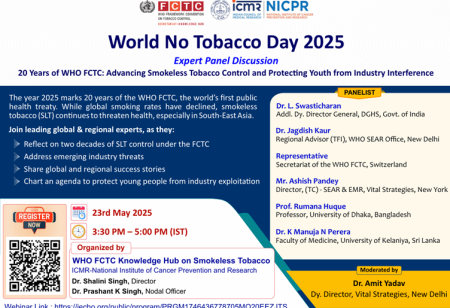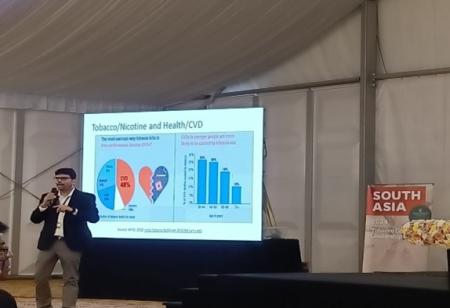
India: Bihar witnesses highest decline in tobacco use - 27 February 2018

Global Adult Tobacco Survey (GATS) Bihar revealed that overall tobacco use prevalence declined among adults in Bihar but more sustained efforts are required to reduce tobacco use prevalence. Also, the prevalence of tobacco use among age group of 15 to 17 has decreased sharply from 21.7% in GATS 1 to less than one per cent in GATS 2
The Global Adult Tobacco Survey (GATS) is a global standard for systematically monitoring adult tobacco use (smoking and smokeless) and tracking key tobacco control indicators.
The second round of Global Adult Tobacco Survey (GATS 2) survey from Bihar, revealed that overall tobacco use prevalence has significantly declined. The prevalence of smoking decreased by 9.1 percentage points and smokeless tobacco by 25.2 percentage points. The prevalence of any tobacco use has also significantly decreased by 27.6 percentage points from 53.5 % in GATS 1 to 25.9 % in GATS 2.
Dr Ravi Mehrotra, director of National Institute of Cancer Prevention and Research (NICPR) said, “Bihar has registered the highest decrease in tobacco use prevalence across all states for which the second round of GATS data has been released in the country, so far. This phenomenal decrease is across products including smoking and smokeless.”
He added, “Looking at the colossal burden of tobacco use, in the state, this is quite positive and encouraging informationIt indicates to the effectiveness of a comprehensive implementation of tobacco control programme and other efforts and initiatives taken by the state government. The key to successfully implementing a health programme like tobacco control is to have a strong collaborative effort from all stakeholders including both government and non-government stakeholders. The tobacco control example from Bihar must be emulated by all the states and stakeholders in the country.”
Key findings of the survey:
6.6% of men, 3.4% of women and 5.1% of all adults currently smoke tobacco.
41.9% of men, 3.6% of women and 23.5% of all adults currently use smokeless tobacco.
43.4% of men, 6.9% of women and 25.9% of all adults either smoke tobacco and/or use smokeless tobacco.
Khaini and bidi are the two most commonly used tobacco products, 20.4% of adults use khaini and 4.2% of adults smoke bidi.
The mean age at initiation of tobacco use has increased marginally from 18.8 years in GATS 1 to 18.9 years in GATS2.
45.1 % of smokers were advised by a healthcare provider to quit smoking and 37.0% of smokeless tobacco users were advised by a healthcare provider to quit smokeless tobacco use.
16.8% of all adults who worked indoors were exposed to second-hand smoke at their workplace.
22.5% of all adults were exposed to second-hand smoke at any public place.
48.5% of cigarette smokers and 51.3% of bidi smokers thought of quitting smoking because of the warning label. Whereas, 49.6% of smokeless tobacco users thought of quitting smokeless tobacco users thought of quitting smokeless tobacco because of the warning label.





